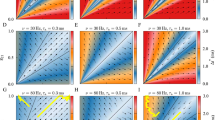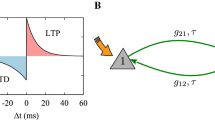Abstract
Recent experimental results by Talathi et al. (Neurosci Lett 455:145–149, 2009) showed a divergence in the spike rates of two types of population spike events, representing the putative activity of the excitatory and inhibitory neurons in the CA1 area of an animal model for temporal lobe epilepsy. The divergence in the spike rate was accompanied by a shift in the phase of oscillations between these spike rates leading to a spontaneous epileptic seizure. In this study, we propose a model of homeostatic synaptic plasticity which assumes that the target spike rate of populations of excitatory and inhibitory neurons in the brain is a function of the phase difference between the excitatory and inhibitory spike rates. With this model of homeostatic synaptic plasticity, we are able to simulate the spike rate dynamics seen experimentally by Talathi et al. in a large network of interacting excitatory and inhibitory neurons using two different spiking neuron models. A drift analysis of the spike rates resulting from the homeostatic synaptic plasticity update rule allowed us to determine the type of synapse that may be primarily involved in the spike rate imbalance in the experimental observation by Talathi et al. We find excitatory neurons, particularly those in which the excitatory neuron is presynaptic, have the most influence in producing the diverging spike rates and causing the spike rates to be anti-phase. Our analysis suggests that the excitatory neuronal population, more specifically the excitatory to excitatory synaptic connections, could be implicated in a methodology designed to control epileptic seizures.
Similar content being viewed by others
References
Abbott LF, van Vreeswijk C (1993) Asynchronous states in networks of pulse-coupled oscillators. Phys Rev E 48(2): 1483–1490
Brighina F, Scalia SS, Gennuso M, Lupo I, Matta F, Piccoli T, Fierro B (2004) Hypo-excitability of cortical areas in patients affected by Friedreich ataxia: a TMS study. J Neurol Sci 235: 19–22
Burrone J, O’Bryne M, Murthy VN (2003) Multiple forms of synaptic plasticity triggered by selective suppression of activity in individual neurons. Nature 420: 414–418
Chaudhury D, Wang LM, Colwell CS (2005) Circadian regulation of hippocampal long-term potentiation. J Biol Rhythms 20(3): 225
Cline H (2005) Synaptogenesis: a balancing act between excitation and inhibition. Curr Biol 15(6): 203–205
Frohlich F, Bazhenov M, Sejnowski TJ (2008) Pathological effect of homeostatic synaptic scaling on network dynamics in diseases of the cortex. J Neurosci 28(7): 1709
Gerstner W, Kistler W (2002) Spiking neuron models: an introduction. Cambridge University Press, New York
Gluckman BJ, Nguyen H, Weinstein SL, Schiff SJ (2001) Adaptive electric field control of epileptic seizures. J Neurosci 21(2): 590
Houweling AR, Bazhenov M, Timofeev I, Steriade M, Sejnowski TJ (2005) Homeostatic synaptic plasticity can explain post-traumatic epileptogenesis in chronically isolated neocortex. Cereb Cortex 15(6): 834–845
Izhikevich EM (2003) Simple model of spiking neurons. IEEE Trans Neural Netw 14(6): 1569–1572
Izhikevich EM (2004) Which model to use for cortical spiking neurons? IEEE Trans Neural Netw 15(5): 1063–1070
Jolivet R, Lewis TJ, Gerstner W (2003) The spike response model: a framework to predict neuronal spike trains. LCNS 2714:846–853
Knowles WD, Schwartzkroin PA (1981) Local circuit synaptic interactions in hippocampal brain slices. J Neurosci 1(3): 318–322
Le Roux N, Amar M, Baux G, Fossier P (2006) Homeostatic control of the excitation-inhibition balance in cortical layer 5 pyramidal neurons. Eur J Neurosci 24: 3507–3518
Moldakarimov SB, McClelland JL, Ermentrout GB (2006) A homeostatic rule for inhibitory synapses promotes temporal sharpening and cortical reorganization. Proc Natl Acad Sci 103(44): 16526
Song S, Miller KD, Abbott LF (2000) Competitive Hebbian learning through spike-timing-dependent synaptic plasticity. Nat Neurosci 3: 919–926
Stein RB (1967) Some models of neuronal variability. Biophys J 7(1): 37
Talathi SS, Hwang DU, Ditto W, Spano M, Sepulveda H, Mareci T, Carney P (2009) Circadian control of neural excitability in an animal model of temporal lobe epilepsy. Neurosci Lett 455: 145–149
Treiman DM (2001) GABAergic mechanisms in epilepsy. Epilepsia 42(3): 8–12
Turrigiano G (2007) Homeostatic signaling: the positive side of negative feedback. Curr Opin Neurobiol 17(3): 318–324
Turrigiano GG, Nelson SB (2004) Homeostatic plasticity in the developing nervous system. Nat Rev Neurosci 5(2): 97–107
Turrigiano GG, Leslie KR, Desai NS, Rutherford LC, Nelson SB (1998) Activity-dependent scaling of quantal amplitude in neocortical neurons. Nature 391: 892–895
Wilson HR, Cowan JD (1972) Excitatory and inhibitory interactions in localized populations of model neurons. Biophys J 12(1): 1–24
Author information
Authors and Affiliations
Corresponding author
Additional information
Nicholas Fisher and Sachin S. Talathi made equal contributions.
Rights and permissions
About this article
Cite this article
Fisher, N., Talathi, S.S., Carney, P.R. et al. Effects of phase on homeostatic spike rates. Biol Cybern 102, 427–440 (2010). https://doi.org/10.1007/s00422-010-0376-8
Received:
Accepted:
Published:
Issue Date:
DOI: https://doi.org/10.1007/s00422-010-0376-8




